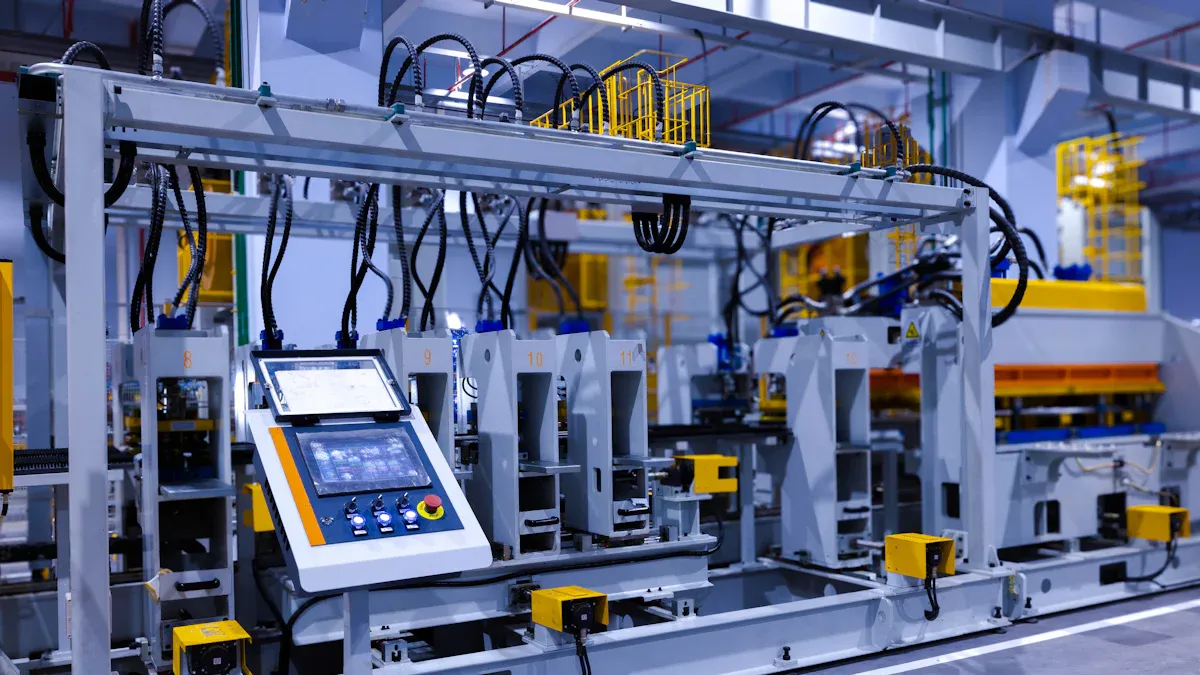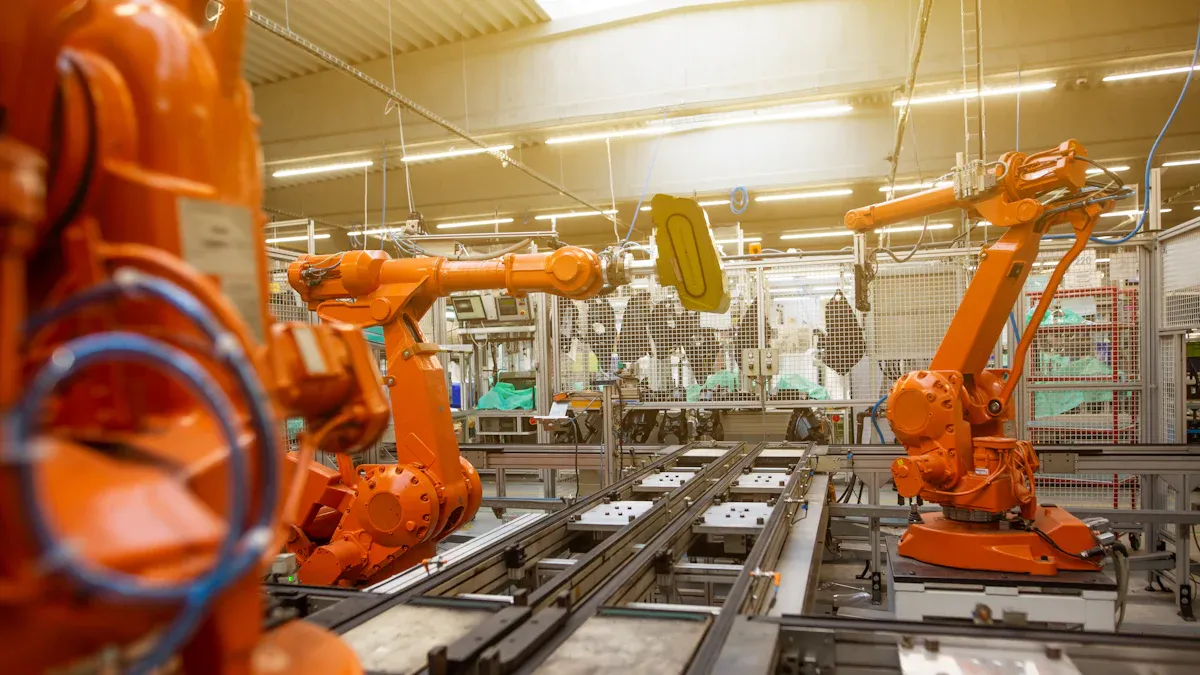Understanding Fool-Proofing and Its Role in Modern Manufacturing

Fool-proofing means you make systems so people do not make easy mistakes. You use fool-proofing to stop errors before they start. This helps make products better in factories. Many people also call fool-proofing mistake-proofing or poka-yoke. Fool-proofing management helps lower defects and makes things more reliable. Studies show people cause about 30% of all mistakes in factories. People also cause 23% of times when machines stop working by accident. Fool-proofing helps stop mistakes and supports new factory goals.
People cause 30% of mistakes in factories.
23% of machine stops happen because of people.
Evidence Type | Description |
|---|---|
Fewer Errors | Using Poka-Yoke helps cut down mistakes at the start. |
Better Product Quality | Making work easier leads to better products and fewer mistakes. |
Saving Money | Stopping mistakes early costs less than finding them later. |
More Work Done | Fewer mistakes help workers do more and feel better, so results improve. |
Stronger Brand and Loyalty | Better products help people trust the brand and keep buying, which helps the company. |
Key Takeaways
Fool-proofing, or poka-yoke, stops mistakes in factories. This leads to better products and fewer problems.
To use fool-proofing, you need to make a team. You should map out the steps and train workers. Workers learn to spot and fix mistakes.
Design features and machines help lower human mistakes. This makes jobs safer and work faster.
Devices like sensors and AI systems find mistakes right away. They help save time and money.
Fool-proofing makes work safer and helps people do more. It also helps customers trust the products because they are better.
Fool-Proofing Overview
What Is Fool-Proofing?
Fool-proofing helps stop mistakes in factories. It sets up ways to catch errors before they cause trouble. In factories, people call fool-proofing poka-yoke or mistake-proofing. Poka-yoke means "mistake-proof" in Japanese. Shigeo Shingo brought poka-yoke to Toyota in the 1960s. He wanted to stop errors before they happened. He did not want to just fix them later. Poka-yoke systems keep products safe and work steady.
Poka-yoke is important in Lean manufacturing. It stops people from making mistakes. It also helps stop bad products. Poka-yoke systems help you do your job right every time.
Poka-yoke was first called "idiot-proofing." The name changed to poka-yoke to be nicer.
Poka-yoke makes work safer and easier.
These systems help you avoid mistakes and make better products.
Core Principles
You follow some main rules when using fool-proofing. These rules help you build poka-yoke systems that work well. They also help keep mistakes away. You can see the main ideas in the table below:
Principle | Description |
|---|---|
Eliminate root causes | Try to remove what causes mistakes so they do not happen. |
Automation | Use machines instead of people when you can. |
Simplification | Make jobs simple so mistakes are less likely. |
Timely information | Give alerts fast if something goes wrong. |
Mitigation | If mistakes happen, make sure they do not hurt your work much. |
You use these ideas to build poka-yoke systems that stop mistakes early. You do not just look for mistakes after they happen. You make your process strong so mistakes cannot get through.
Here is how these ideas are not like old quality checks:
Elimination: You set up your work so mistakes cannot happen.
Replacement: You change risky steps for safer ones.
Prevention: You make it so mistakes cannot happen at all.
Facilitation: You make it easy to do the job right.
Detection: You find mistakes before they become big problems.
Correction: You fix mistakes right away.
Poka-yoke and mistake-proofing help you do better than old quality checks. You do not wait for mistakes. You stop them before they start.
Poka Yoke and Mistake-Proofing
Poka-yoke and mistake-proofing keep factories safe and running well. Poka-yoke is a Japanese word for mistake-proofing. You use poka-yoke to lower mistakes and bad products. Poka-yoke is a big part of lean manufacturing and quality checks.
Poka-yoke helps stop mistakes and waste.
Mistake-proofing stops accidents from happening.
Poka-yoke devices save money by stopping mistakes early.
Poka-yoke systems help make sure every step is done right.
Factories use many kinds of poka-yoke devices today:
Prevention poka-yoke uses machines to stop mistakes, like AGVs that stop if loads are wrong.
Detection poka-yoke uses sensors to find mistakes early.
Contact method uses tools to check if parts fit right.
Fixed value method stops machines if parts are not right.
Motion step method uses safety gates to control steps and keep people safe.
You follow rules for using poka-yoke to make your work strong. Poka-yoke systems help you work better and safer. Poka-yoke and mistake-proofing help people trust your products and your company.
Tip: Using poka-yoke makes your job easier and your products better. It helps your team avoid mistakes and keeps your factory working well.
Fool-Proofing Management

Implementation Steps
You can make your factory safer and more reliable by using fool-proofing management. This process helps you find mistakes before they happen and fix them fast. You need to follow clear steps to set up fool-proofing in your manufacturing area.
Build a team with people from different jobs. This team will look at your processes and find places where mistakes happen.
Choose a process that needs help. You can use a Pareto chart to see which process causes the most problems.
Map out the steps in your process. This helps you see where errors might start.
Use the 5-whys technique to find out why mistakes happen. Ask "why" until you reach the root cause.
Decide how you want to stop mistakes. You can use shut-out methods to block errors or attention methods to warn workers.
Pick the best fool-proofing method for your situation. You might use contact, sequencing, or fixed-value methods.
Test your solution. Run trial tests to make sure your fool-proofing works.
Train your workers. Teach them how to use the new system and check if it helps.
Measure your results. See if the fool-proofing management plan lowers mistakes and improves quality.
Tip: When you use fool-proofing management, you make your factory safer and your products better. You also help your team work with fewer errors.
You may face some challenges when you start fool-proofing management. Machines might slow down while you set up new systems. Workers may need extra help to understand the changes. Checking if your fool-proofing works can take time. Sometimes, costs go up at first, but you save money later by making fewer mistakes.
Identifying Error-Prone Areas
You need to find where mistakes happen most in your manufacturing process. Fool-proofing management starts with spotting these risky areas. You can use different methods and tools to help you.
Method | Description |
|---|---|
Design for Error Prevention | Change your process to remove risky steps and add features that block mistakes. |
Clear and Intuitive Instructions | Use signs, pictures, or even augmented reality to guide workers and make steps easy to follow. |
Automation of Error-Prone Tasks | Use robots or machines for jobs that people find hard or boring. This lowers human error. |
Real-Time Error Detection | Add sensors and use data to catch mistakes as they happen. You can see patterns and fix problems fast. |
Continuous Improvement | Keep checking your process and ask for feedback. This helps you find new risks and fix them quickly. |
You can also use special fool-proofing methods:
Fixed-value method alerts you if a step is missed.
Motion-step method watches the order of actions to make sure workers follow the right steps.
Modern factories use smart tools to find mistakes. Real-time visual prompts help workers see what to do next. Automated quality checks watch machines and catch errors fast. Digital error-proofing systems let you change and grow your process easily. AI-driven visual inspection systems spot defects quickly. IoT devices collect data and show you where problems start. Real-time analytics track how well your process works and help you make smart choices.
Note: When you use these tools and methods, you make fool-proofing management stronger. You find mistakes early and fix them before they hurt your products or slow down your work.
Case Study Example:
A car factory wanted to lower mistakes in its assembly line. The team used fool-proofing management to map the process and found that workers sometimes missed a bolt during assembly. They added a fixed-value method that counted bolts and gave a warning if one was missing. They also used real-time visual prompts to show workers each step. After these changes, mistakes dropped by 80%, and the factory saved money on repairs.
Emoji Callout:
🛠️ You can use fool-proofing management to make your manufacturing process safer, faster, and more reliable!
Methods in Mistake-Proofing in Manufacturing

Design Features
You can use design features to make mistake-proofing strong. Good design helps stop mistakes before they happen. Some machines will not work if the door is open. Fixtures hold parts in the right spot. Safety guards protect workers from moving parts. Sensors check for missing pieces during each step. These features make your factory safer and more reliable.
Strategy | Description |
|---|---|
Design changes force you not to make errors, like automated controls. | |
Mistake Detection | You spot mistakes right away and fix them fast. |
Fail-Safing | Safety systems lower the harm if a mistake happens. |
Work Environment | Simple steps and clear jobs help you avoid confusion and errors. |
Real-world examples show how design features save money and improve quality. One company switched a part from machining to sand casting. They saved $57,000 each year. Another company made corners bigger so tools fit better. This cut costs by 17%. Car safety alerts and treadmill clips also use mistake-proofing to keep people safe.
Process Standardization
You need process standardization to make mistake-proofing work well. Standard templates help you find and fix errors. When everyone follows the same steps, you lower the chance of mistakes. This keeps your factory strong and helps you reach your goals.
Experts say real success starts when you build strong processes and keep improving them. Standardization is more than just good instructions. It creates a culture where you always look for ways to do better.
Standardized workflows help you detect and fix defects at the source. They help you set up tasks and workstations in the best order. You follow Standard Operating Procedures every time. This lowers changes that hurt quality and productivity.
When you use process standardization, you make training easier and speed up onboarding. You can track progress with Key Performance Indicators and see how well your mistake-proofing works.
Employee Training
Employee training is key for mistake-proofing. You teach your team why fool-proofing matters and how poka-yoke helps. You involve workers in finding risk areas and improving processes. You use feedback loops to spot problems early and fix them fast.
Training Aspect | Purpose |
|---|---|
Feedback Loop | Find problems early and fix them quickly. |
Improvement Initiative | Follow the PDCA cycle and use clear signs to manage accountability. |
Best practices for employee training include teaching staff about poka-yoke and fool-proofing. You get your team to help with improvement. You track error rates before and after changes. Start with simple solutions like checklists and color coding. Review and improve processes often.
You can use three levels of mistake-proofing in training. First, detect errors before they happen with warning systems. Second, stop the process if you find a mistake. Third, design jobs so mistakes cannot happen at all.
Error Detection Devices
Error detection devices make mistake-proofing stronger in modern factories. You use automated inspection systems with AI, machine learning, and high-resolution cameras. These tools check for defects faster and more accurately than manual checks. Real-time error detection lets you spot problems as they happen and fix them right away.
Recent case studies show big improvements. AI defect detection systems increased detection rates by 50%. Automated visual inspection cut defect escape rates by 94%. Detection accuracy for critical defects reached 99.7%. Customer complaints dropped by 85%. Production throughput rose by 32%. Companies saved $1.8 million each year in quality costs.
You can use sensors, cameras, and smart software to make your factory safer and more efficient. These devices help you reach high levels of quality and show how well mistake-proofing works.
Benefits of Error Proofing
Quality Improvement
Error proofing helps make products better. It catches mistakes before they turn into bad products. When factories use error proofing, they have fewer defects. Many factories say error proofing cuts defects by half. Some factories see even bigger drops, up to 90%. This means customers get better products. Fewer products are returned. Customers trust the company more because products work well.
Error proofing means fewer mistakes.
Product quality and customer happiness go up.
Cost Reduction
Error proofing saves money for factories. Stopping mistakes early means less money spent fixing problems. Fool-proofing and error-proofing help lower waste and costs. Poka-yoke stops expensive errors and helps teams keep improving. Factories save money on overhead, sometimes between 5% and 30%. Poka-yoke helps use resources better and lowers waste.
Cost Savings (%) | Description |
|---|---|
5% to 30% | Fewer defects and less rework save money in manufacturing. |
Factories use materials better and waste less.
Fool-proofing makes work faster and smoother.
Safety and Productivity
Error proofing makes work safer and helps people do more. Fool-proofing and error-proofing stop accidents and keep workers safe. Error-proofing makes jobs easier and lowers human mistakes. This means workers get more done and quality stays high. Training new workers takes less time because jobs are simple. Teams work faster and make fewer errors.
Benefit | Description |
|---|---|
Improves Safety | Error-proofing keeps workers safe by stopping mistakes before they happen. |
Higher Productivity | Simple jobs help workers do more and work better. |
Reduces Waste | Catching mistakes early means less waste and better use of materials. |
Error-proofing makes work safer and faster.
Teams finish more work with fewer mistakes.
Fool-proofing helps build a strong team.
Challenges and Limitations
Factories can have problems with error proofing. Sometimes, people want to find and fix mistakes instead of stopping them. It can be hard to know which mistakes can be fixed and which cannot. Tracking where mistakes are found is not always easy. Factories may not know how much a mistake costs when it is found. Some do not know which jobs use batch flow or single piece flow.
People may not choose prevention over fixing mistakes.
It is hard to know which mistakes can be fixed.
Factories may not track where mistakes are found.
They may not know the cost of a mistake when it is found.
Factories may not know which jobs use batch or single piece flow.
Simple fool-proofing like poka-yoke can help with these problems. These methods stop mistakes and make work better. Inspectors find mistakes fast, so there is less rework and waste. Focusing on stopping mistakes builds a stronger factory.
Fool-proofing helps you make strong systems in factories. Poka-yoke stops mistakes before they happen. This keeps quality high and waste low. Many leaders say fool-proofing helps companies succeed for a long time. You keep making your process better every day with small changes. Lean and Six Sigma use fool-proofing to stop defects. These methods help teams work smarter and faster. When you care about quality and always improving, your products become safer and more reliable.
Poka-yoke helps make better products and less waste.
Fool-proofing helps you improve every step of the way.
FAQ
What is the main goal of fool-proofing in manufacturing?
You use fool-proofing to stop mistakes before they happen. This helps you make better products and keep your factory safe. Fool-proofing also saves money by reducing waste and rework.
How does poka-yoke work on the factory floor?
Poka-yoke uses simple devices or steps to catch errors. For example, a sensor can check if a part is in the right place. If something is wrong, the system alerts you right away.
Can you use fool-proofing in small factories?
Yes, you can use fool-proofing in any size factory. Simple tools like checklists, color codes, or guides help you avoid mistakes. You do not need expensive machines to start.
What are some common fool-proofing devices?
Device Type | Example Use |
|---|---|
Sensors | Detect missing parts |
Guides | Help place items correctly |
Alarms | Warn about errors |
These devices help you spot and fix mistakes quickly.
Why should you train workers on mistake-proofing?
Training helps your team understand how to use fool-proofing tools. When everyone knows what to do, you catch mistakes early and keep quality high.
See Also
Understanding QFD, FMEA, And DOE's Impact On Quality
Essential Concepts That Define Lean Manufacturing Practices
An Overview of Jigs And Fixtures in Manufacturing
Introduction To SMED: A Beginner's Manufacturing Guide
Comparing Discrete And Process Manufacturing: Two Distinct Approaches
About Hunan Puka
Established in 2016 and based in Hunan, China, with a liaison point in Berlin, we are a Tier 2 supplier for the automobile industry. We specialize in the production of customized aluminum die-casting parts designed for machines with a closing force ranging from 280 to 1250 tons, with subsequent manufacturing process CNC machining and surface treatment. Our commitment to quality is reflected in our accredited quality management system, certified by ISO9001:2015 and IATF16949:2016 standards.


